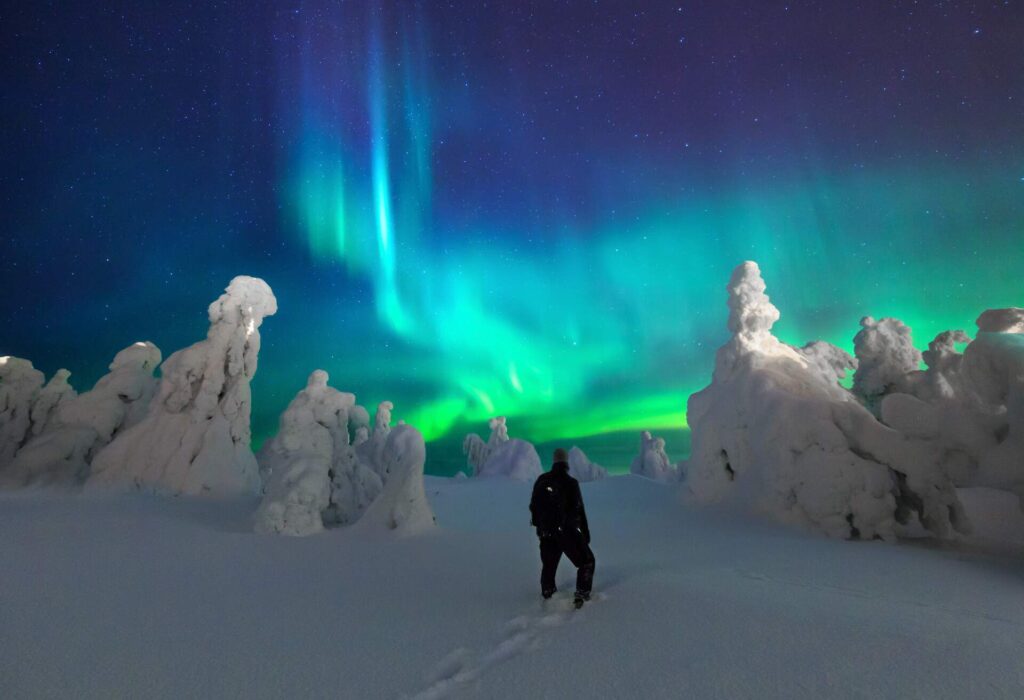
The Northern Lights, or aurora borealis, are one of the most breathtaking natural phenomena on Earth. As we approach the solar maximum between July 2024 and January 2025, solar activity will reach its peak, offering an unparalleled opportunity to witness these dazzling light displays. If you’re planning an aurora hunting trip, this guide highlights the best locations, ideal viewing times, and expert tips to ensure you experience the magic of the Northern Lights in all their glory.
Finnish Lapland, Finland – A Winter Wonderland for Aurora Spotters
Why Visit?
Finnish Lapland, located at 67° north latitude, is one of the top places to witness the aurora borealis. With nearly 200 nights of visible Northern Lights per year and minimal light pollution, this destination offers a high probability of a spectacular show.
Best Locations:
- Rovaniemi – The capital of Lapland and home to Santa Claus Village.
- Inari – A remote location with pristine nature and excellent aurora viewing spots.
- Levi – A resort town offering glass igloos and luxury stays.
Best Time to Visit:
- Peak months: Late August to early April
- Optimal viewing hours: 10 PM to 2 AM
Additional Activities:
- Husky sledding and snowmobiling
- Ice fishing and reindeer safaris
- Staying in glass-roofed igloos for an unforgettable night under the lights
Iceland – The Land of Fire, Ice, and Auroras
Why Visit?
Iceland’s geographic position at 65° north makes it one of the best places to witness the aurora borealis. The island’s low population and vast wilderness provide excellent opportunities to escape light pollution for crystal-clear views of the lights.
Best Locations:
- Thingvellir National Park – A UNESCO World Heritage site with stunning landscapes.
- Reykjavik outskirts – Quick access to dark-sky spots without leaving the capital.
- Jökulsárlón Glacier Lagoon – A surreal setting where the lights reflect on icy waters.
Best Time to Visit:
- Peak months: October to March
- Optimal viewing hours: 9 PM to 2 AM
Additional Activities:
- Exploring ice caves and glaciers
- Relaxing in geothermal hot springs
- Visiting waterfalls like Seljalandsfoss and Skogafoss
Swedish Lapland – A Remote Arctic Paradise
Why Visit?
Swedish Lapland, covering 25% of the country, offers unspoiled Arctic landscapes ideal for Northern Lights hunting. It also boasts unique accommodations like the world-famous Icehotel and the Treehotel.
Best Locations:
- Abisko National Park – Known for its microclimate, which provides clearer skies.
- Kiruna – Sweden’s northernmost town with a high probability of aurora sightings.
- Luleå – A coastal town with a mix of urban amenities and wilderness access.
Best Time to Visit:
- Peak months: October to March
- Optimal viewing hours: 6 PM to 2 AM
Additional Activities:
- Ice fishing and hovercrafting over frozen lakes
- Moose safaris and reindeer sleigh rides
- Sleeping in an ice room at the Icehotel
Tromsø & Svalbard, Norway – The Northern Lights Capital
Why Visit?
Norway’s latitude of 62° north places it directly under the aurora oval, making it one of the best locations for consistent Northern Lights displays. Its long winter nights provide an extended viewing window.
Best Locations:
- Tromsø – Dubbed the “Gateway to the Arctic” with plenty of aurora tours.
- Svalbard – One of the few places on Earth where you can see the aurora during the daytime (polar night period).
Best Time to Visit:
- Peak months: September to March
- Optimal viewing hours: 6 PM to 1 AM
Additional Activities:
- Dog sledding and fjord cruises
- Staying in traditional Sami tents
- Enjoying the “polar night” experience where the sun doesn’t rise for weeks
Alaska, USA – The Ultimate Wilderness Aurora Experience
Why Visit?
Alaska’s vast, sparsely populated landscapes offer some of the best conditions for viewing the Northern Lights in North America. The further north you go, the higher your chances of seeing the lights.
Best Locations:
- Fairbanks – One of the most reliable places for aurora sightings.
- Denali National Park – A remote wilderness offering clear, dark skies.
- Talkeetna – A charming town known for unique accommodations and aurora tours.
Best Time to Visit:
- Peak months: September to April
- Optimal viewing hours: 10 PM to 3 AM
Additional Activities:
- Aurora viewing from fly-in lodges
- Exploring vast national parks and wildlife reserves
- Hot springs bathing under the aurora sky
Tips for Maximizing Your Northern Lights Experience
Choose the Right Conditions
- Travel during peak aurora season.
- Avoid full moon nights, as they create light pollution.
- Check solar activity forecasts and KP index levels.
Find the Darkest Locations
- Escape city lights and head to rural or national park areas.
- Use apps like “Aurora Forecast” to track aurora visibility.
- Book accommodations in remote areas with aurora-friendly amenities.
Be Prepared for Cold Weather
- Dress in layers with thermal insulation.
- Wear gloves, hats, and heat-retaining boots.
- Bring hand warmers and hot drinks for comfort during long viewing sessions.
Capture the Aurora Borealis Like a Pro
- Use a DSLR or mirrorless camera with manual settings.
- Set ISO between 800-3200, with a long exposure of 5-20 seconds.
- Use a tripod to avoid shaky images.
Conclusion
With the upcoming solar maximum, 2024-2025 presents a rare opportunity to witness the Northern Lights at their peak brightness and frequency. Whether you’re exploring the Arctic Circle in Finland, venturing into Iceland’s volcanic landscapes, or heading to the remote wilderness of Alaska, each destination offers a unique backdrop for this celestial phenomenon. Plan ahead, pick the right location, and prepare for an unforgettable journey beneath the shimmering aurora borealis.